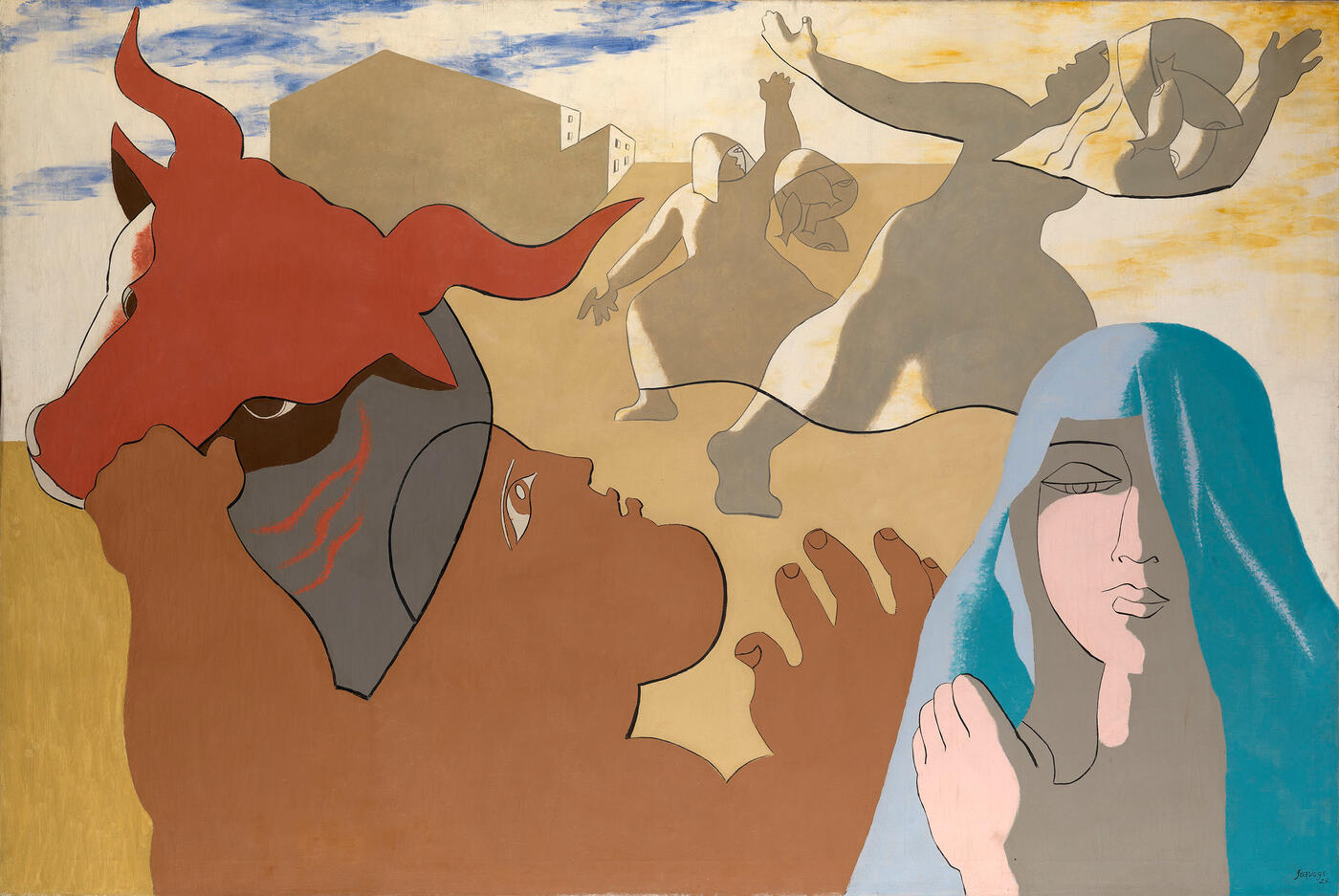27 Nov 2013 Russian Art Auctions
27 November 2013

*§ 83. SURVAGE, LÉOPOLD (1879-1968)
Le Taureau échappé, signed and dated 1928.
Oil on canvas, 160.5 by 240.5 cm
300,000–400,000 GBP
The present lot is one of two decorative wall panels created by Survage in 1928
for the Union Catholique de Théâtre et de la Musique, Paris.
Provenance: Salle de l’Union Catholique de Théâtre et de la Musique, Paris, from 1928.
Possibly, with Galerie Françoise Friedrich, Cologne, until 1980.
Important private collection, Paris.
Anonymous sale; Collection d’un amateur, Tajan, Paris, 19 November 2003, lot 115.
Private collection, Europe.
Authenticity of the work has been confirmed by the expert Yu. Rybakova.
Exhibited: Survage, exposition rétrospective, Musée Galliera, Paris, 6 April–2 May 1966, No. 55.
Survage, Musée des Beaux-Arts, Lyon, June–September 1968, No. 27.
Leopold Survage, Galerie Friedrich, Cologne, 1 March–19 April 1980, No. 4.
Literature: S. Putnam, The Glistening Bridge. Leopold Survage and the Spatial Problem in Painting, New York, Covici-Friede, 1929, p. 163, pl. 30, illustrated; p. 10, listed.
P. Fierens, Survage, Paris, Editions des Quatre Chemins, 1931, pl. 30, illustrated and listed as Toreau [sic] et Pecheuses.
Exhibition catalogue, Survage, exposition rétrospective, Paris, Musée Galliera, 1966, No. 55, listed.
Exhibition catalogue, Survage, Lyon, Musée des Beaux-Arts, 1968, p. 26, illustrated.
Exhibition catalogue, Survage, Cologne, Galerie Françoise Friedrich, 1980, listed and reproduced on the cover.
The work will be included in the forthcoming catalogue raisonné being prepared by E. Brosset.
Le Taureau echappé is one of two works commissioned from Léopold Survage to decorate the walls of the Union Catholique du Théâtre et de la Musique in Paris. Destined for the walls of a dramatic organisation, the nature of the murals’ commission called for monumental, visually impressive works on the theme of drama and allegory. This was in perfect accord with Survage’s artistic preoccupations at the time, namely a perceptible movement towards grandiose, neo-classical forms and the exploration of space and volume.
The year of the present lot’s execution is significant for a number of reasons. In 1928 the artist had published an essay and manifesto entitled “The Plastic Synthesis of Space”, and this year also marked what his friend and biographer Samuel Putnam was to describe as the beginning of a new and disconcerting period: “the conquest of a new freedom in fluidity, the discovery of form in freedom”. As proof of Survage’s victory in the creative challenges he had set himself, Putnam directs the reader to “those little short of astounding decorations for the Salle de l’Union Catholique du Théâtre.”
Le Taureau echappé belongs to the artist’s Collioure period, a period of seven years (1925–1932) where he summered in that little settlement in the Pyrenees so beloved of artists – a potent combination of French and Catalan cultures whose atmosphere was so conducive to creativity. One salient characteristic of the present lot is its sense of duality, particularly the duality and juxtaposition of the classical or mythological with real events set in a real time and place.
In this work we recognise the Catalan imagery that characterises his Collioure works: the semi-deified women clothed in headscarves and flowing robes, the fish-sellers carrying baskets of anchovies on their heads, the distinctive stepped architecture of the town and, most importantly, the bull. One day Survage was to witness a memorable event in the life of when a bull broke free from the herdsmen and charged around the town causing chaos and terror. The artist captured the dramatic scene on paper as it unravelled before him and the visual drama of the event, the contrast of the panic of the townswomen with the sang-froid of the herdsmen as they cornered the beast, was to leave a lasting impression and recurred frequently as a motif in his works of this period. Le Taureau echappé is one of the key works of Survage’s oeuvre, not only does it represent the apogee of his explorations of space and volume beyond the limitations of Cubism, but also the finest of his Collioure period.
Notes on symbols:
* Indicates 5% Import Duty Charge applies.
Ω Indicates 20% Import Duty Charge applies.
§ Indicates Artist's Resale Right applies.
† Indicates Standard VAT scheme applies, and the rate of 20% VAT will be charged on both hammer price and premium.